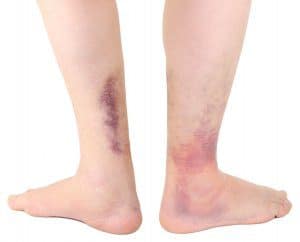Distal Fibula Fracture

What is a Distal Fibula Fracture?

A Distal Fibula Fracture is another name for a broken leg. A serious sports injury or accident, may cause one of bones within your legs to fracture, such as the fibula and tibia(below the knee), and the femur (above the knee). The fracture occurs when the bone experiences more pressure than it can handle. One can splinter, split, or completely break the bone in several pieces. IF YOU BELIEVE THAT SOMEONE HAS A BROKEN LEG, YOU SHOULD IMMEDIATELY CALL 911 AND AVOID MOVING THEM IF POSSIBLE.
- If you suddenly experience extreme pain in your leg. (Any extreme and sudden onset of pain is something you should check out immediately).
- Blue bruising can sometimes appear.
- If the leg contorts in an unnatural way, or the bone is sticks out of the skin.
 How can my doctor tell if my leg fractured?
How can my doctor tell if my leg fractured?
Your doctor will take some of the following steps to see if you have a broken leg:
There are a few methods that your doctor will use to determine the severity of your injury.
Symptoms Of Distal Fibula Fracture
Other symptoms of a fibula fracture besides pain and swelling include:
Tenderness and bruises in the lower leg pain that worsens with pressure tingling or numbness, which typically occurs when there has been a neurovascular injury
The tibia and other affected joints and bones may also exhibit symptoms.
History and Examination
- They will likely complete a history. She will ask you if the pain started before any kind of physical exertion, and whether or not the limb has had a break before.
- They will examine your leg and check for obvious signs of breakage.
- Finally, if they do suggest a break they will order an x-ray to determine the magnitude of the break. This information will help them formulate a plan for recovery.

How do you treat a Distal Fibula Fracture?
Do not move the limb if you suspect yours or someone else’s leg has a break. Wait until emergency personnel can check it out. Ignore this if the person afflicted is in immediate danger.
After a doctor examines the limb and determines it is broken, then they will concoct a treatment plan best suited for the type of break.
How can one prevent future fractures after recovering from a distal fibula fracture?
Preventing future fractures after recovering from a distal fibula fracture involves adopting proactive measures to enhance bone health and minimize risks. Here’s how:
- Nutrition: Maintain a balanced diet rich in calcium and vitamin D to support bone strength and density.
- Exercise: Engage in weight-bearing and resistance exercises to promote bone health and muscular strength.
- Fall Prevention: Be cautious on uneven surfaces and use proper footwear to reduce the risk of falls.
- Avoid Smoking: Quit smoking, as it can weaken bones and slow healing.
- Limit Alcohol: Moderation in alcohol consumption is advised, as excessive intake can weaken bones.
- Bone Density Testing: If at risk, consider bone density testing to assess bone health and identify potential issues.
- Medication Review: Consult with a healthcare provider to ensure medications don’t negatively impact bone health.
- Balance and Strength Training: Incorporate exercises that improve balance and stability to prevent falls.
- Home Safety: Make your living space safe by removing tripping hazards and adding handrails if needed.
How can pain and swelling be managed during the recovery process?
Managing pain and swelling during the recovery process after a distal fibula fracture involves a combination of strategies. Here’s how to effectively address these discomforts:
- Rest and Elevation: Elevate the injured leg whenever possible to reduce swelling. Keep it elevated above heart level to promote fluid drainage.
- Cold Therapy: Apply ice packs or cold compresses to the affected area for 15-20 minutes at a time, several times a day, to minimize swelling and numb pain.
- Pain Medications: Over-the-counter pain relievers like acetaminophen or non-steroidal anti-inflammatory drugs (NSAIDs) can help manage pain and reduce inflammation. Follow your healthcare provider’s recommendations.
- Prescribed Medications: If prescribed, take pain medications as directed by your doctor to manage pain effectively.
How Long Distal Fibula Fracture Takes To Heal?
The recovery period and healing speed of distal fibula fracture depends on the severity of the fracture and the treatment used to treat it, however here’s the average timeline:
- Small or non-displaced fractures: Since they are small, they take at least 6-8 weeks to heal completely. However, rest and following medications is necessary for full recovery.
- Displaced or serious fracture: More Serious fractures usually require surgery especially if they are displaced, these can take at least 8-12 weeks or longer to heal, depending on the extent of the injury and recovery process.
Furthermore, if your bone is healed it may require physical therapy, which is used to restore strength and mobility, which will take additional weeks or months. Unfortunately, a full recovery which allows you to continue sports and normal activities will take longer, at least 3-6 months.
What Complications You May Experience From Distal Fibula Fracture?
Complications from distal fibula fracture includes:
- Delayed Healing: If your fracture takes longer to heal or fails to heal it can increase chances of infection or non healing wounds.
- Malunion: The bone may heal, but it may heal in an incorrect position which causes deformity or even altered function.
- Ankle Instability: Damage to ligaments or improper healing results in chronic ankle disability.
- Post-Traumatic Arthritis: Join damage from fractures lead to arthritis over time especially in ankle.
- Nerve Damage: Nerves around the fracture sties can get damaged as well, which leads to numbness and tingling.
How To Manage Pain That’s Associated From Distal Fibula Fracture?
If you experience pain then consider resting, elevation, ice or immobilization with cast or boot. Try over-the-counter pain relievers like ibuprofen or acetaminophen if needed. Your doctor will prescribe you with medications, so take them and do not put any strain on the affected area.
Surgical Consideration
Consider surgery often to treat a fractured leg. The surgeon chooses the treatment method based on the severity of the fracture.
While you can mend some breaks without surgery, it’s quite possible that you will need to undergo surgery to realign the bones and or apply support structures.
Only your doctor can tell you exactly how long the recovery process will take, as it depends on multiple factors such as the severity of the break and whether or not surgery was required.
If you think you may have broken your ankle or leg call today so we can xray, diagnose , and treat all in one visit!
Call 878-313-3338
